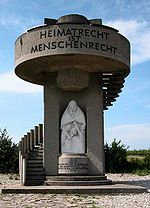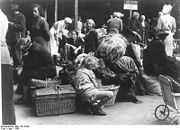
Heimatvertriebene
Encyclopedia


Expulsion of Germans after World War II
The later stages of World War II, and the period after the end of that war, saw the forced migration of millions of German nationals and ethnic Germans from various European states and territories, mostly into the areas which would become post-war Germany and post-war Austria...
from parts of Germany annexed by Poland and Russia, and from other countries, who found refuge in both West
West Germany
West Germany is the common English, but not official, name for the Federal Republic of Germany or FRG in the period between its creation in May 1949 to German reunification on 3 October 1990....
and East Germany, and Austria
Austria
Austria , officially the Republic of Austria , is a landlocked country of roughly 8.4 million people in Central Europe. It is bordered by the Czech Republic and Germany to the north, Slovakia and Hungary to the east, Slovenia and Italy to the south, and Switzerland and Liechtenstein to the...
. Refugees who had fled voluntarily but were later refused permission to return are often not distinguished from those who were forcibly deported.
In a document signed in 1950 the Heimatvertriebene organisations recognized the plight of the different groups of people living in today's Poland who were resettled there by force. The Heimatvertriebene are just one (but by far the largest) of the groups of millions of other people, from many different countries, who all found refuge in today's Germany.
Some of the expellees are active in politics and belong to the political right wing. Many others do not belong to any organizations, but they continue to maintain what they call a lawful right to their homeland. The vast majority pledged to work peacefully towards that goal while rebuilding post-war Germany and Europe.
The expellees are still highly active in German politics, and are one of the major political factions of the nation, with around 2 million members. The president of the Federation of Expellees
Federation of Expellees
The Federation of Expellees or Bund der Vertriebenen is a non-profit organization formed to represent the interests of Germans who either fled their homes in parts of Central and Eastern Europe, or were expelled following World War II....
is a member of the Bundestag
Bundestag
The Bundestag is a federal legislative body in Germany. In practice Germany is governed by a bicameral legislature, of which the Bundestag serves as the lower house and the Bundesrat the upper house. The Bundestag is established by the German Basic Law of 1949, as the successor to the earlier...
.
Although expellees and their descendants were active in West German politics, the prevailing political climate within West Germany was that of atonement for Nazi
Nazism
Nazism, the common short form name of National Socialism was the ideology and practice of the Nazi Party and of Nazi Germany...
actions. However the CDU
Christian Democratic Union (Germany)
The Christian Democratic Union of Germany is a Christian democratic and conservative political party in Germany. It is regarded as on the centre-right of the German political spectrum...
governments have shown considerable support for the expellees and German civilian victims.
Expellee towns
As a result of the huge influx of expellees, there was a massive increase of population in some areas such as MecklenburgMecklenburg
Mecklenburg is a historical region in northern Germany comprising the western and larger part of the federal-state Mecklenburg-Vorpommern...
(where population numbers doubled), and in some places the previous homogeneity of the population was broken by Protestant expellees moving to a purely Catholic area or conversely. The population numbers of a number of small settlements in West Germany exploded permanently due to a refugee camp on their territory or nearby. Examples of this phenomenon include Neugablonz, a quarter of Kaufbeuren
Kaufbeuren
Kaufbeuren is an independent city in the Regierungsbezirk of Schwaben, southern Bavaria. The city is completely enclaved within the district of Ostallgäu.- Culture and Objects of Interest :* Townhall * Crescentiakloster...
in Bavaria
Bavaria
Bavaria, formally the Free State of Bavaria is a state of Germany, located in the southeast of Germany. With an area of , it is the largest state by area, forming almost 20% of the total land area of Germany...
, founded by the expellees and named after Gablonz (Jablonec nad Nisou)
Jablonec nad Nisou
Jablonec nad Nisou is a town in northern Bohemia, the second largest town of the Liberec Region. It is known as a mountain resort in the Jizera Mountains, an education centre, and a centre of world-production of glass and jewellery...
. Neugablonz nowadays makes up a third of the town's population. An extreme example of the population explosion is Neutraubling
Neutraubling
Neutraubling is a town in the state of Bavaria in southern Germany, in the district of Regensburg.The town has only existed since 1951. After the second world war, displaced Germans from the eastern parts of the Reich settled in the ruins of the bombed military airport. Today, it is a more or less...
(also in Bavaria), which had 53 inhabitants in 1947, 1300 in 1951, and 3800 in 1960. Since the refugee camps were mostly located on the sites of former hidden ammunition factories, most of these Vertriebenenstädte are located in a (former) forest.
See also
- Aussiedler (:de:Aussiedler)
- Expulsion of Germans after World War IIExpulsion of Germans after World War IIThe later stages of World War II, and the period after the end of that war, saw the forced migration of millions of German nationals and ethnic Germans from various European states and territories, mostly into the areas which would become post-war Germany and post-war Austria...
- Federation of ExpelleesFederation of ExpelleesThe Federation of Expellees or Bund der Vertriebenen is a non-profit organization formed to represent the interests of Germans who either fled their homes in parts of Central and Eastern Europe, or were expelled following World War II....
- Glossary of the Third ReichGlossary of the Third ReichThis is a list of words, terms, concepts, and slogans that were specifically used in Nazi Germany.Some words were coined by Adolf Hitler and other Nazi Party members. Other words and concepts were borrowed and appropriated, and other terms were already in use during the Weimar Republic...

